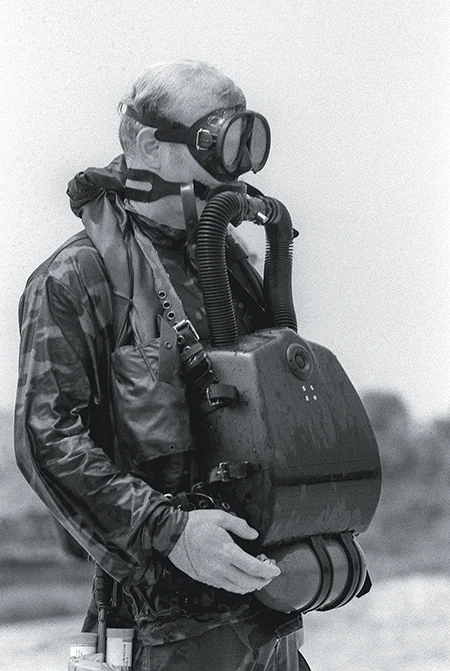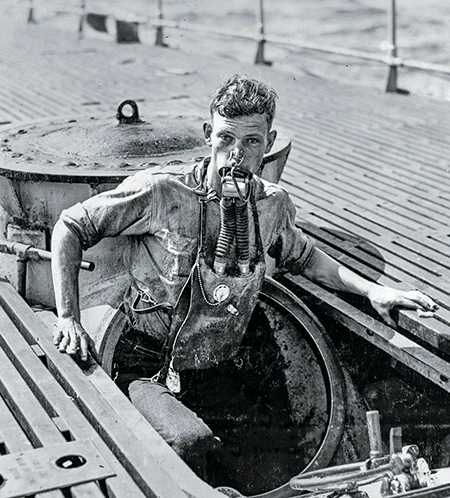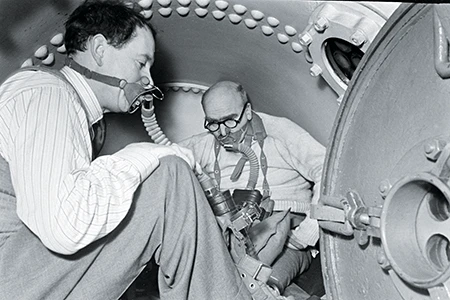In 1943 a hyperbaric chamber in London reached an air pressure equal to 300 feet (91 meters), and nitrogen narcosis hammered the three dry divers inside. They reached for the rubber mouthpieces of their dive gear, which delivered 100% oxygen. One diver didn’t think the oxygen tasted like anything. Another argued it tasted like onions. After five minutes of pure oxygen at that depth, they spit out their mouthpieces and decompressed.
We’re not supposed to breathe oxygen at greater than 1.3 atmospheres (atm) of partial pressure (pO2), or maybe 1.4 or perhaps 1.6, but 1.6 only for a short time and if it’s an emergency. So how did those three World War II-era divers escape disaster at 10.1 atm of oxygen for five minutes? How did their intentional experiment at these extremes turn into modern safety guidelines with levels 10 times lower? The answer to the first question is simply that they were fortunate. The answer to the second is part of a longer history of oxygen limits.
Modern dive limits for oxygen toxicity have their roots in World War II, when combat divers used higher partial pressures of oxygen. German U-boats ravaged the oceans during the two world wars, and Allied countries struggled to build submarine technology for an underwater world they did not fully understand. They did it anyway, however, as they needed to maintain a balance of power in the Atlantic. These submarine designers needed a way to give their crews hope in the event of a sinking.

Seeing an opportunity to expand into a new market, companies that made breathing systems for mine workers started modifying their closed-circuit, carbon-dioxide-scrubbing breathing apparatuses. They changed the gaskets, waterproofed the materials, and made new mouthpieces so the devices would work underwater. This equipment became part of the Allied plans for submarine escape.
The breathing apparatuses for miners used bottles of pure, pressurized oxygen as the gas supply, and the manufacturers did the same thing for these new underwater versions. The navies using these systems provided no depth-based safety limits because few knew what could happen.
The first recorded oxygen toxicity seizure in humans occurred in 1933. Academic researchers pressurized themselves to 4 atm and documented an account of the strange event, but it stayed in the world of physiologists. Nobody needed the oxygen rebreathers for an escape at that time, so the oversight went undetected.
Then in 1939 the USS Squalus went down on May 23, the HMS Thetis on June 1, and the French Phénix on June 15. The British managed to recover four crew members alive from the cold North Atlantic waters of the Thetis wreck site, but these survivors were in such bad shape that it took days before they could tell their stories. The British navy suspected that oxygen had something to do with the crew members’ conditions and realized they needed more testing on these new rebreathers. That was the start of the experimentation that produced our modern guidelines.

On May 31, 1940, scientist John “J.B.S.” Haldane experienced the second known seizure from oxygen toxicity in humans. He along with fellow researcher Martin Case and a team at manufacturer Siebe Gorman had taken the lead on testing the rebreathers. At 300 feet Haldane began to have spasms in his face, and then the spasms spread to his limbs. He lost consciousness as he convulsed, and Case yanked out Haldane’s mouthpiece. Suspecting the oxygen, Case removed his mouthpiece too.
This experiment, in which Haldane seized and Case did not, provides the key insight into why the risks of oxygen toxicity are so hard to describe with precision: The test group realized that the risk of a seizure from oxygen toxicity was probabilistic for humans.
The variability of human physiology means we struggle to predict what will happen to a specific person during a particular action. The best information researchers can provide is the probability that a person will get hurt, a clear understanding of the risk, and grouped recommendations. To calculate the probability of oxygen toxicity, the scientists would need enough data from human divers to do the math.
The Siebe Gorman group conducted more than 611 tests on themselves in the air and water while exercising and at rest and using various configurations of dive equipment. The scientists experienced seizures during 14 tests, sometimes multiple times per test. British navy divers served as additional subjects for another 600 data points, which included 77 more seizures.

Helen Spurway, PhD, turned this new data into mathematical curves describing the percent chance that a diver would experience oxygen toxicity based on the diver’s pO2 and time. Spurway’s models determined a diver breathing a pO2 above 1.8 entered the realm where, given enough time, symptoms became inevitable. A diver breathing 2.5 atm had only 10 minutes before having a 5% chance of oxygen toxicity. That percentage may seem low, but in the world of probabilities that 5% risk accumulates with every dive.
The limit inside a hyperbaric chamber is different from in water. The usual pO2 in a chamber is 2.8 atm; while seizures sometimes occur, the subjects are inside a chamber and cannot drown. While underwater, however, divers’ mouthpieces without retaining straps can dislodge and increase the risk of drowning.


Since World War II, researchers have accumulated even more data, and we now know that oxygen toxicity does not typically appear until around 1.3 to 1.4 atm, but there is no precise way to determine a limit above that. Divers who exceed limits and utilize a higher pO2 may develop a false sense of safety when nothing happens, but they may experience an incident on a subsequent dive.
The current guidelines consider the level at which we have no documented oxygen toxicity and recommend cutoff levels slightly lower because the adverse effects of an oxygen toxicity event underwater are so severe. Until we can determine how to predict oxygen toxicity events without high-risk and unethical experiments, we must follow the limits derived from past experiments during times of war. Otherwise, with every dive we gamble that we won’t have the same experience as Haldane.
Explore More
Learn more about oxygen toxicity in this video presentation by Richard Vann, PhD.
© Alert Diver – Q4 2024